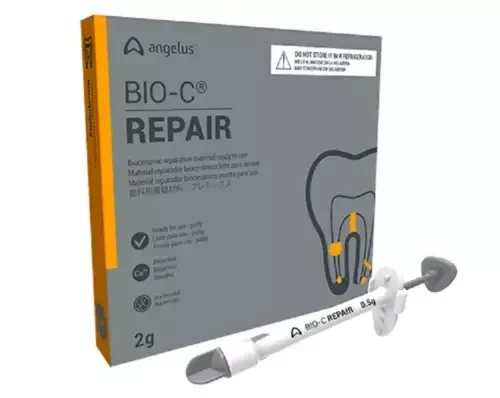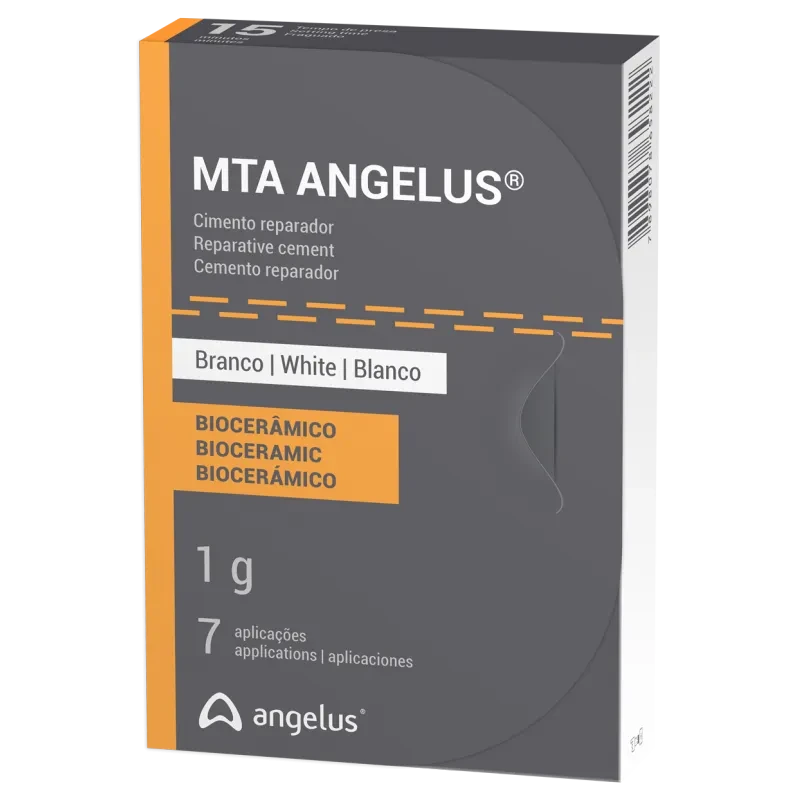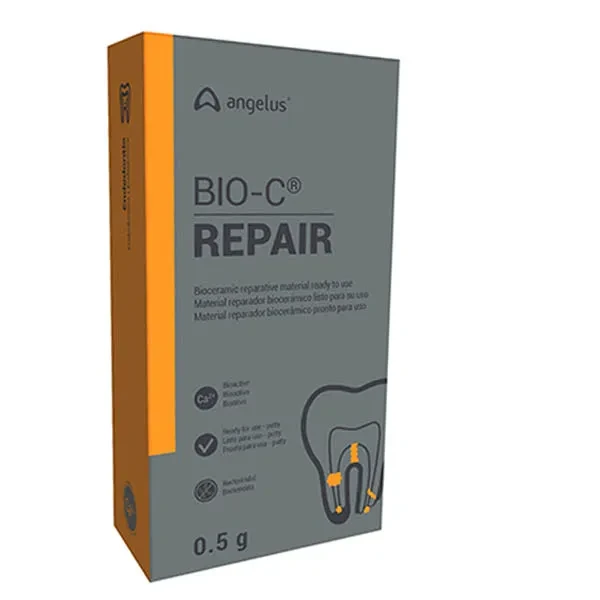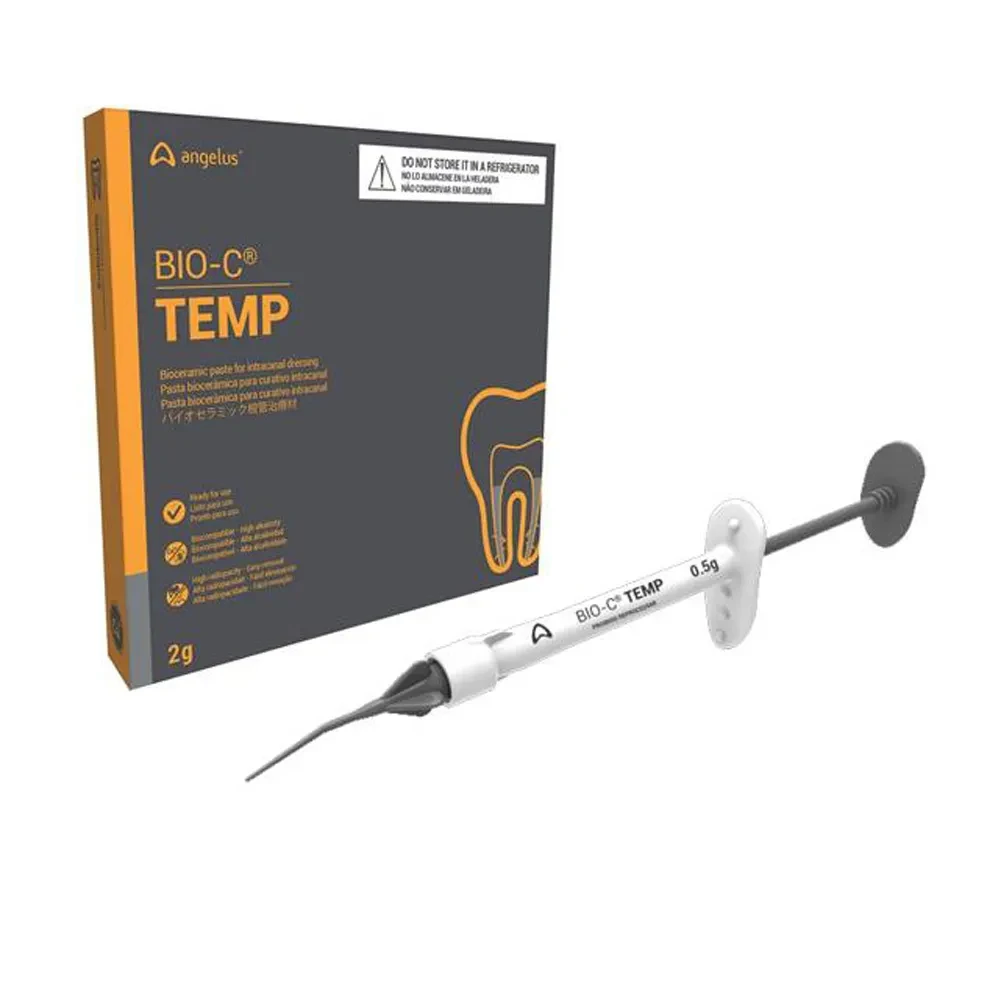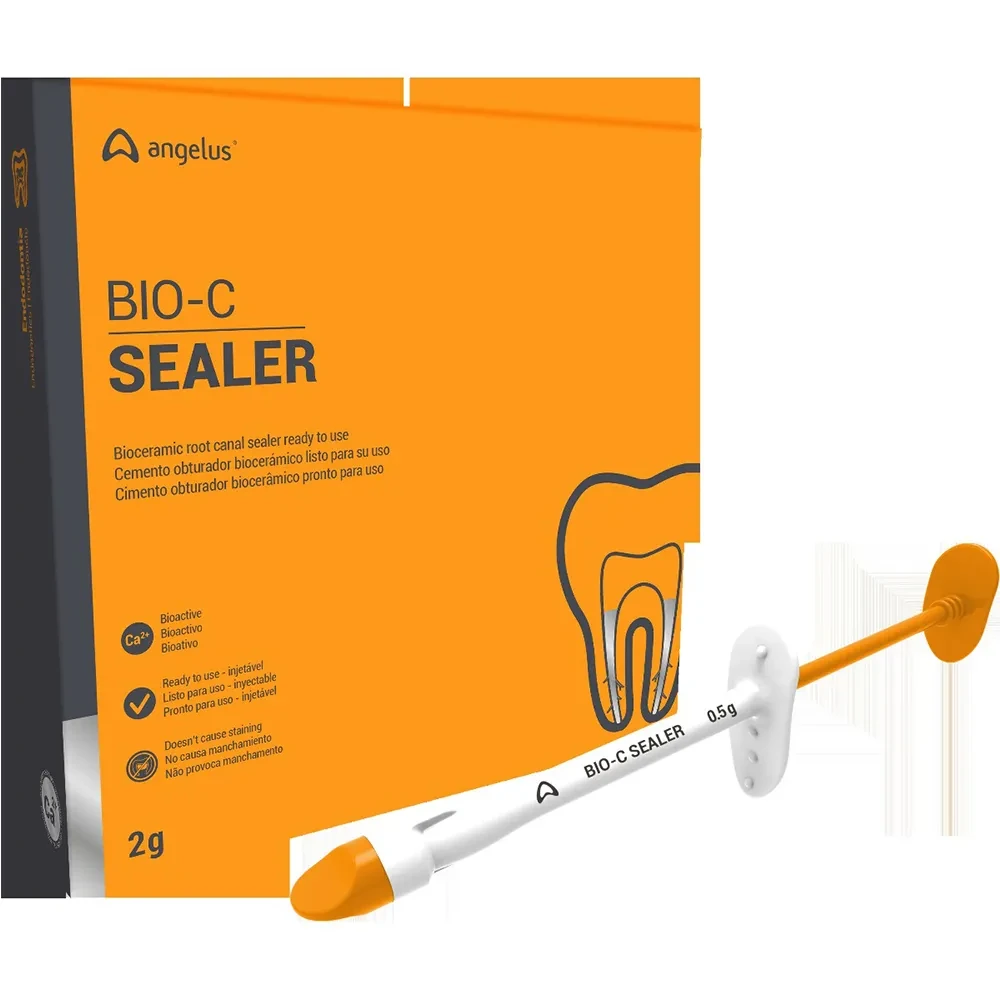







Angelus Bio-C Sealer Bioceramic Root Canal Sealers
-
$79.85
-
$133.08
-
$133.08
-
$23.75
-
$34.75
Reviews & Ratings
COMPOSITION
Calcium Silicates, calcium aluminate, calcium oxide, zirconium oxide, iron oxide, silicon dioxide and dispersing
agent
Bio-C Sealer is a non-resin cement that, in addition to its improved biocompatibility properties, also provides an easy
pulp chamber cleaning after endodontic obturation.
Bio-C Sealer is a ready-to-use bioceramic cement for root canal filling.
The bioceramic composition allows the release of calcium ions, which stimulates the formation of mineralized tissue.
Its mechanical and physical properties make it easy to manipulate and seal the canals, and its biological properties
and high pH confer safety and treatment success.
RECOMMENDATION
Filling root canals.
More than biocompatible, it’s bioactive! Ready-To-Use Bioceramic Filling Cement.
Features:
Dispenses mixing
Totally biological and easy to clean
Antibacterial action
Accelerated repair
Excellent radiographic visualization
Does not stain
Excellent flow
Easy to use
Prevents bacterial infiltration
Ready to use
Non-resinous
Alkaline
Bioactivity with release of calcium ions
High Radiopacity
Radiopacifier with Zirconium
Suitable fluidity
Injectable
Interaction with dentin
Key Specifications:
TECHNICAL INFORMATION
Biocompatible product ready for use;
Working time: 60 minutes;
Setting time: 120 minutes (2 hours) after insertion into the canal, according to ISO 6876; Important: Dry with paper cones, but without excessively drying the canal the moisture from the dentin tubules will initiate the material’s setting reaction.
Antibacterial and bacteriostatic due to its high alkalinity - pH: 12.5;
High radiopacity: 7 mm of aluminum scale, according to the ISO 6876 standard;
Does not suffer setting contraction;
It can be used, in addition to conventional techniques, in single-cone techniques and thermoplastic filling.
Packaging:
Angelus Bio-C Sealer Bioceramic Root Canal Sealer
1 x 0.5gm Syringe
5 x Applicator tips
Angelus Bio-C Sealer Bioceramic Root Canal Sealer
4 x 0.5gm Syringe
20 x Applicator tips
Direction to Use:
USE TECHNIQUE
Use of Applicator Tips
1. Position the applicator tip in the syringe and perform the chemical decontamination of the assembly (tip + syringe)
2. We recommend using a disposable plastic cover on the syringe to avoid cross-contamination;
3. Confirm the material exits from the syringe before direct application to the channel;
4. Position the tip and syringe assembly properly into the canal and depress the plunger lightly to prevent excessive output of the product.
5. Before closing the syringe, retract the plunger to stop the outflow;
6. Clean any excess material on the tip of the syringe and close with appropriate pressure after use to prevent
contact with moisture, which causes the product to dry 4
7. Clean and disinfect the syringe in subsequent uses to avoid cross-contamination; in case of contamination with saliva or blood, discard it.
A. SEALING THE ROOT CANAL OF PERMANENT TEETH
Traditional technique - Lateral compression
1. Anesthetize, install absolute isolation and then perform the biomechanical preparation of the canal;
2. Remove the sealing tip and attach the applicator tip on the syringe;
3. Dry the canal only with absorbent paper cones without causing excessive dryness;
4. Apply BIO-C SEALER in the apical third of the canal directly with the syringe;
5. Insert the gutta percha cone in the canal according to the last file used covered with BIO-C SEALER;
6. X-ray for checking the correct filling of the canal;
7. Cut the cone at the desired height with heated instruments followed by vertical compression;
8. Remove, with water, excessive material from the canal walls, perform crown sealing and restoration.
Important:
BIO-C SEALER does not suffer setting contraction;
BIO-C SEALER can be used, in addition to conventional techniques, in single-cone techniques and
thermoplastic filling;
To use the capsule presentation, place it on the gun, depress the plunger to dispense the material on a glass
plate or dispense it directly into the canal, performing one of the techniques mentioned above;
Use conventional gutta removal techniques.
Single-cone technique
1. Anesthetize, install absolute isolation and then perform the biomechanical preparation of the canal;
2. Remove the sealing tip and attach the applicator tip on the syringe;
3. Dry the canal only with absorbent paper cones without causing excessive dryness;
4. Apply BIO-C SEALER in the apical third of the canal directly with the syringe;
5. Insert the gutta percha cone;
6. X-ray for checking the correct filling of the canal;
7. Cut the cone at the desired height with heated instruments followed by vertical compression;
8. Remove excessive material from the canal walls with suitable irrigating solutions for this purpose, perform
crown sealing and restoration.
B.INTERNAL REABSORPTION TREATMENT
1. Anesthetize and install absolute isolation;
2. Remove granulation tissue from reabsorption area with sharp curettes;
3. Neutralize the area with calcium hydroxide paste;
4. Remove the calcium hydroxide in the next session;
5. Dry the canal only with absorbent paper cones without causing excessive dryness;
6. Insert BIO-C SEALER with the applicator tip across the canal, prioritizing the reabsorption area;
7. Insert the accessory gutta percha cones according to the lateral compression technique;
8. Cut the cones at the upper part of the reabsorption with heated instruments. Perform vertical compression
for better disposal of the sealer in the reabsorption area;
9. X-ray for checking the correct filling of the reabsorption and canal area;
10. Fill the remaining of the canal with gutta percha;
11. Perform crown sealing with glass ionomer or other material of your preference and restore the tooth;
12. X-ray and follow up for at least two years
Filling removal
Use conventional gutta removal techniques.
Frequently Bought Products
Product Queries (0)
Login Or Registerto submit your questions to seller
Other Questions
No none asked to seller yet
-
$79.85
-
$133.08
-
$133.08
-
$23.75
-
$34.75
Dentistry Deal | DENTAL CARE PRODUCTS WITH GREAT DEALS
Finding good deals on dental care products can help you maintain oral hygiene without breaking the bank. Whether you're looking for toothpaste, floss, mouthwash, or even an electric toothbrush, there are several strategies you can use to save money:
1. Coupons and Discounts: Many dental care brands offer coupons either online or in newspapers and magazines. Websites dedicated to savings often have printable coupons or promo codes for online purchases.
2. Sales and Promotions: Keep an eye on local supermarkets, pharmacies, and big-box retailers for sales on dental products. These stores frequently offer discounts or "buy one, get one free" deals, especially during seasonal promotions.
3. Subscription Services: Some companies offer subscription services where dental care products are delivered regularly (monthly or quarterly). These subscriptions often come with a discount compared to buying products individually.
4. Bulk Purchases: Buying dental products in bulk can often reduce the cost per unit. Warehouse stores or online retailers may offer significant discounts for buying larger quantities.
5. Rebates: Occasionally, manufacturers offer rebates on dental care products. After purchasing, you can submit a rebate form along with proof of purchase to receive money back.
6. Store Loyalty Programs: Signing up for loyalty programs at your favorite stores can earn you points or discounts on future purchases, including dental care items.
7. Online Shopping: Comparison shop online to find the best prices. Many online retailers offer lower prices than brick-and-mortar stores, and you can often find additional discounts through promo codes or sales.
8. Manufacturer Websites: Check the websites of dental care product manufacturers for special offers, promotions, or loyalty programs that can help you save money.
9. Cashback Offers: Some credit cards or cashback websites offer cashback rewards for purchases at certain retailers or on specific categories, including health and personal care items.
10. Generic Brands: Consider trying generic or store-brand dental care products, which are often cheaper than name-brand options but can be just as effective.
By combining these strategies, you can find excellent deals on dental care products without compromising on quality. Regularly checking for discounts and promotions ensures that you can maintain your oral health regimen affordably.
When looking for dental care products, it's important to choose ones that are manufactured by FDA-approved companies. The FDA (Food and Drug Administration) regulates dental care products to ensure they are safe and effective for consumer use. Here are a few key points to consider:
FDA Approval: Ensure that the dental care products you purchase are approved by the FDA. This approval indicates that the product has undergone rigorous testing and meets safety and efficacy standards set by the FDA.
Reputation of the Company: Look for products from reputable companies that have a history of producing quality dental care items. Established brands often prioritize safety and efficacy in their products.
Product Labels: Check the product labels for information such as FDA registration numbers, ingredient lists, and usage instructions. Legitimate products will have clear and accurate labeling.
Reviews and Recommendations: Read reviews from other consumers and dental professionals to get insights into the effectiveness and safety of the products. Reliable reviews can help you make informed decisions.
Dental Professional Recommendations: Consult your dentist or dental hygienist for recommendations on FDA-approved dental care products that suit your specific oral health needs.
Avoid Counterfeit Products: Be cautious of purchasing dental care products from unauthorized sellers or sources. Counterfeit products may not meet FDA standards and could potentially be harmful.
Online Purchases: If purchasing online, buy from reputable websites and official manufacturer's sites to reduce the risk of receiving counterfeit or substandard products.
Check for Recalls: Periodically check FDA announcements or recalls related to dental care products to stay informed about any safety concerns or issues.
By choosing dental care products from FDA-approved companies, you can feel confident that you're using products that meet stringent safety and efficacy standards. Prioritizing quality and safety in your oral care routine contributes to maintaining good oral health over the long term.

